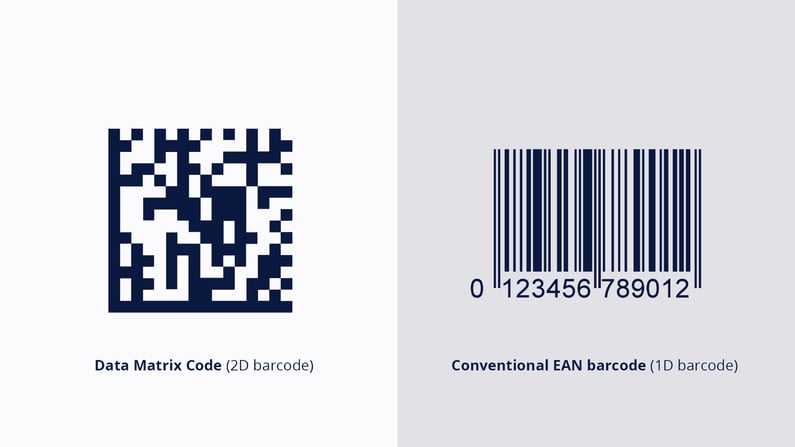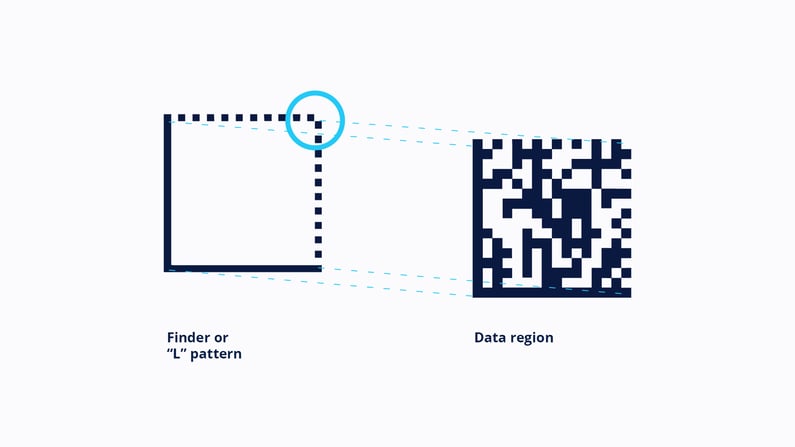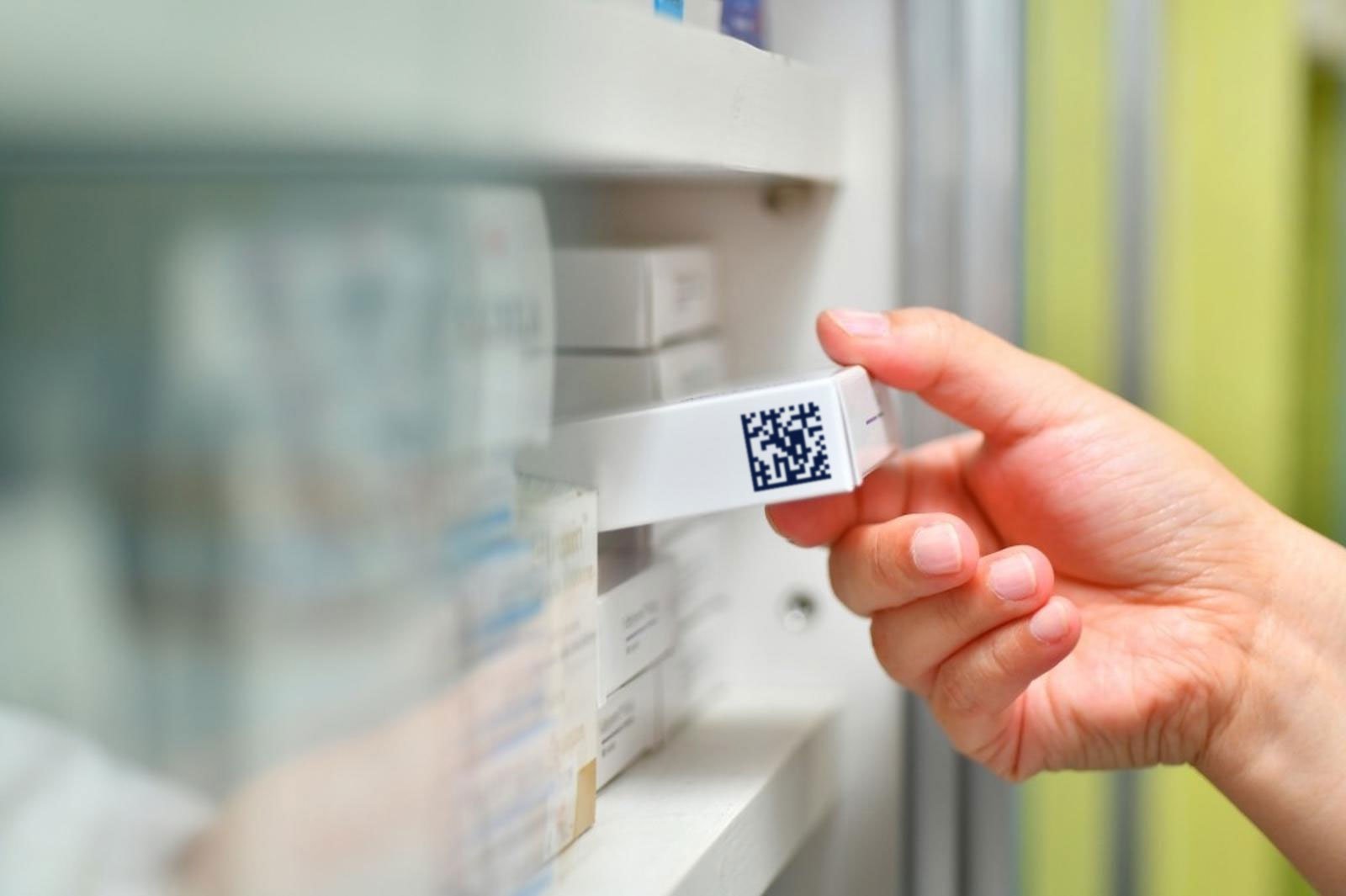Along with other GS1 technologies and standards, GS1 DataMatrix is revolutionizing healthcare industry and logistics operations in global supply chains!
Unlike other GS1 symbologies, the GS1 DataMatrix barcode is two-dimensional (2D). This means that it allows you to encode a large amount of information within a tiny space.
Laser-etched onto the surface of a product, the GS1 DataMatrix becomes unerasable and resistant to adverse conditions, such as substances from industrial environments that can cause wear and tear.
So in conditions where conventional (or linear) barcodes are not suitable, GS1 DataMatrix gets the job done!
This is our comprehensive guide to the technical aspects of GS1 DataMatrix that you need to know about before making any decisions!
1D and 2D Code: Is there really that much difference between the two?

Don't know the difference between the different types of barcodes?
- One-dimensional barcodes, known as 1D, encode data in only one direction.
- Two-dimensional barcodes, 2D, encode data in an enclosed area in two directions.
1D codes, also called linear barcodes, are symbols with parallel lines of varying widths and spacings and contrasting colors - like EAN codes!
2D codes are data matrix codes, square in shape in most applications. They encode information in small squares of contrasting colors that form the time stamp pattern. In addition, 2D codes also have a location pattern (in the shape of an "L").
Understand the GS1 DataMatrix barcode once and for all
The DataMatrix barcode has some older versions, but the DataMatrix ECC 200 version is the most up-to-date.
The ECC 200 version was internationally standardized and also responsible for updating the code's error correction, aiming to put an end to distortion problems once and for all.
Inside the GS1 DataMatrix
- Barcode Version: DataMatrix ECC200.
- FNC1: GS1 spec added on top of the data.
- Application Identifier: Code added right at the beginning of the data range that defines the categories of data that accompany the code.
From now on, whenever you read the name GS1 DataMatrix in this text, assume that we are talking about the most up-to-date version, ECC 200!
Learn about the GS1 DataMatrix structure
GS1 DataMatrix is a code applicable in a myriad of operations in different industries, consisting of two parts:
- The Localization Pattern: which allows the scanner to locate the information in the printed code;
- And the data: which is the information encoded there.
The Localization Pattern is responsible for defining the square or rectangular shape, the minimum size of the black and white dots, and the number of rows and columns of the printed code.
This Location Pattern is the dark line that we can see just below and to the left of the printed code. In it the coded data correspond to numeric and alphanumeric characters.
The other two sides are the Synchronism Clock, alternating in black and white squares, which defines the basis of the printed code's structure.

GS1 DataMatrix still has the Clear Zone (a mandatory white border, also present in linear codes). The zone has a constant width on all sides equal to the X-Dimension of the printed code: which is the minimum size of the black and white squares.
Specifically in the ECC 200 version of GS1 DataMatrix, the printed code has an even number of rows and columns. So the version always has a white square in the upper right corner.
The printed code format
The GS1 DataMatrix code can be printed in two symbol formats. The choice depends on the space available on the product, the amount of data to be encoded, the type of printing and other technical factors.

The square shape can encode larger amounts of data, so it is the most widely used. Still, the rectangular shape solves specific needs for printing speed on the production line.
The rectangular shape, with limited height, is best suited when industries need to apply some high-speed printing technique covering a large quantity of items. More prints in less time, without any errors!
Coding Capability
The size of the printed GS1 DataMatrix (square or rectangular) is a result of the amount of data encoded within it.
The rectangular format has the possibility of 6 different sizes, always varying the number of rows and columns. The square format can reach up to 24 different dimensions when printed.
Maximum square format coding capacity:
- 2335 alphanumeric characters;
- 3116 numeric characters.
In rectangular format:
- 72 alphanumeric characters;
- 98 numeric characters.
Error Correction: Reed-Solomon
The ECC 200 version is the only version that works on error correction in a systematic way, locating errors and correcting them when possible.
Reed-Solomon is a specific group of error-correcting codes. They allow corrupted data to be recovered through the old complete original message.
According to GS1 Global definitions, Reed-Solomon works as follows: it reconstitutes the previously coded data from a calculation that recovers it and locates the errors during the code capture (from printing problems, application degradation, etc.).
It can locate and correct a specific amount of erroneous symbols. As an erasure code, it corrects a specific amount of deletions in places unknown to the algorithm or corrects combinations of errors and deletions
The location of the printed code

Here it is important to note that the location of the GS1 DataMatrix on a product should be determined by the manufacturer, considering:
- The available space for printing on the packaging;
- The type of product, the type of printing and the material used (printing on packaging, label, etc.);
- The purpose of the code (will it be read in an automated environment? By manual readers?).
As we discussed in the topic "Get to know the GS1 DataMatrix structure", the Silent Margin is a decisive factor when applying the GS1 DataMatrix and can be a limitation, so it needs some attention!
Folds in the packaging, bends, or seams can get in the way of reading the code, so they should also be considered when choosing the most appropriate location.
Reading and decoding the printed code
Once printed, the GS1 DataMatrix can be read with a scanning device that captures the encoded data. Scanning the code refers to two steps of the process:
- Scanning: reading the contrast between the black and white squares;
- The decoding: processing the coded data.
But being a two-dimensional (2D) barcode, the GS1 DataMatrix can only be scanned by imaging cameras (the same ones found on smartphones and tablets, for example).
Conventional scanners - those present in everyday retailers - only recognize linear lines. Camera scanners, which recognize 2D codes, can also easily capture traditional 1D codes.
This is a sign that investing in technology is always a good way to go.
After decoding, the data is sent to an information system, where the information is processed again.
After this brief technical guide, do you still have any questions? The GS1 DataMatrix barcode is one of the most widely used worldwide and has been updated in several versions.
Remember: our expert team specialized in serialization and traceability solutions is ready to answer your questions and guide you through the best decisions for your business. We are just a few clicks away!


COMMENTS